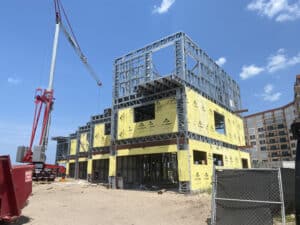How Light Gauge Steel Framing Reduces Construction Waste and Supports Sustainable Building Practices
Sustainability in construction has become a growing priority for developers and builders alike, particularly in commercial projects where environmental impact can be significant. One of the most effective ways to reduce construction waste and contribute to sustainable building practices is by utilizing Light Gauge Steel (LGS) framing. Not only is steel one of the most recyclable materials available, but the use of prefabricated components and efficient construction processes ensures minimal waste and a lower carbon footprint. In this post, we’ll explore how LGS framing reduces construction waste and supports eco-friendly building practices for commercial projects.
1. Minimal Material Waste Through Precision Fabrication
A major cause of construction waste is the need for on-site cutting, adjusting, and reworking of materials. With Light Gauge Steel framing, the precision of fabrication virtually eliminates these issues, reducing material waste during the construction process.
- Prefabricated Components: LGS components are manufactured off-site to exact specifications, ensuring that each piece fits perfectly upon arrival at the job site. This reduces the need for on-site cutting or modification, which often results in wasted materials.
- Precision Engineering: Because steel components are fabricated with advanced machinery, they are engineered to exact tolerances, meaning there’s little to no room for error. This results in consistent quality and minimal offcuts or scrap.
- Streamlined Assembly: With prefabricated components, the assembly process is faster and more efficient, further reducing the amount of material waste that typically accumulates on-site.
By reducing the need for on-site modifications and minimizing errors, LGS framing helps developers maintain a leaner, more sustainable construction process with significantly less material waste.
2. Steel’s Recyclability: A Key to Sustainable Construction
One of the standout sustainability features of Light Gauge Steel is its recyclability. Steel can be recycled infinitely without losing its strength or durability, making it one of the most environmentally friendly building materials available.
- 100% Recyclable Material: Every piece of LGS framing is fully recyclable, which means that any steel waste generated during construction can be melted down and reused for future projects. This drastically reduces the amount of construction waste sent to landfills.
- Recycled Content: Many steel products used in construction are made from recycled materials, further contributing to the circular economy. By using steel, developers are not only reducing waste but also supporting the use of recycled resources in their projects.
- Contribution to Green Building Standards: The use of recycled and recyclable materials helps developers achieve sustainability certifications such as LEED (Leadership in Energy and Environmental Design). Steel’s recyclability is a key factor in earning points in the Materials and Resources category of LEED certification.
By using a fully recyclable material, developers can minimize the environmental impact of their projects and contribute to a more sustainable construction industry.
3. Reducing On-Site Waste with Prefabrication
Traditional construction methods often generate significant waste due to on-site modifications, cutting, and disposal of excess materials. Prefabricated LGS components help to mitigate this waste by ensuring that components arrive ready for assembly.
- Less Excess Material: Since steel components are fabricated off-site with precision, there is less excess material to deal with on the job site. This means less scrap, fewer offcuts, and a reduction in the amount of construction waste that would typically need to be discarded.
- Controlled Manufacturing Process: In the controlled environment of a manufacturing facility, steel components are cut, shaped, and prepared with minimal waste. Any waste that is produced during the manufacturing process is recycled, further reducing the environmental impact.
- Cleaner Job Sites: Prefabricated components result in cleaner job sites, as there is no need for on-site fabrication or cutting. This reduces the amount of debris that must be hauled away, lowering the overall waste management costs and contributing to a more sustainable building environment.
The prefabrication process not only saves time and improves efficiency but also plays a significant role in reducing the waste generated during commercial construction projects.
4. Energy Efficiency and Reduced Carbon Footprint
Light Gauge Steel framing contributes to energy-efficient building practices, which play a crucial role in reducing the overall carbon footprint of commercial projects. By improving the energy performance of a building, LGS framing supports long-term sustainability goals.
- Improved Thermal Performance: LGS framing systems are designed to reduce thermal bridging, which helps maintain consistent indoor temperatures and reduces the energy required for heating and cooling. This is especially important in Florida, where high energy costs for air conditioning are common.
- Compatibility with Insulation Systems: LGS framing can be paired with high-performance insulation systems, further enhancing the energy efficiency of commercial buildings. Reduced energy consumption not only lowers operating costs but also decreases the building’s environmental impact.
- Sustainable Manufacturing Processes: The production of steel has become more energy-efficient over the years, with many manufacturers adopting sustainable practices that reduce greenhouse gas emissions. This makes LGS framing an environmentally responsible choice from the production phase through the life cycle of the building.
By improving the energy efficiency of commercial buildings, LGS framing supports the reduction of carbon emissions and contributes to the overall sustainability of the construction project.
5. Longevity and Durability: Less Need for Repairs and Replacements
A sustainable building is one that is built to last, and Light Gauge Steel framing offers the durability needed to ensure long-term stability without the need for frequent repairs or replacements.
- Resistant to Pests and Moisture: Steel is impervious to pests like termites and resistant to moisture-related issues such as mold or rot. This means that buildings framed with LGS are less likely to experience structural damage over time, reducing the need for costly repairs and the environmental impact of material replacements.
- Fire Resistance: Steel’s natural fire-resistant properties add another layer of durability, reducing the risk of fire-related damage. This further supports the longevity of the building and ensures that fewer materials are needed for repairs or rebuilds after fire incidents.
- Long-Term Sustainability: Because LGS framing maintains its structural integrity over decades, it helps extend the life of the building and reduces the frequency with which major renovations or rebuilds are required. This contributes to a reduction in the use of new materials and resources.
The long-lasting durability of LGS framing means fewer resources are consumed in maintaining the building, supporting a more sustainable, low-impact construction process.
Conclusion: LGS Framing for Sustainable Commercial Construction
For developers focused on reducing waste, improving efficiency, and supporting sustainable building practices, Light Gauge Steel framing is an ideal choice. From its recyclability and reduced material waste to its energy efficiency and durability, LGS framing helps commercial projects meet sustainability goals while maintaining strength and performance.


